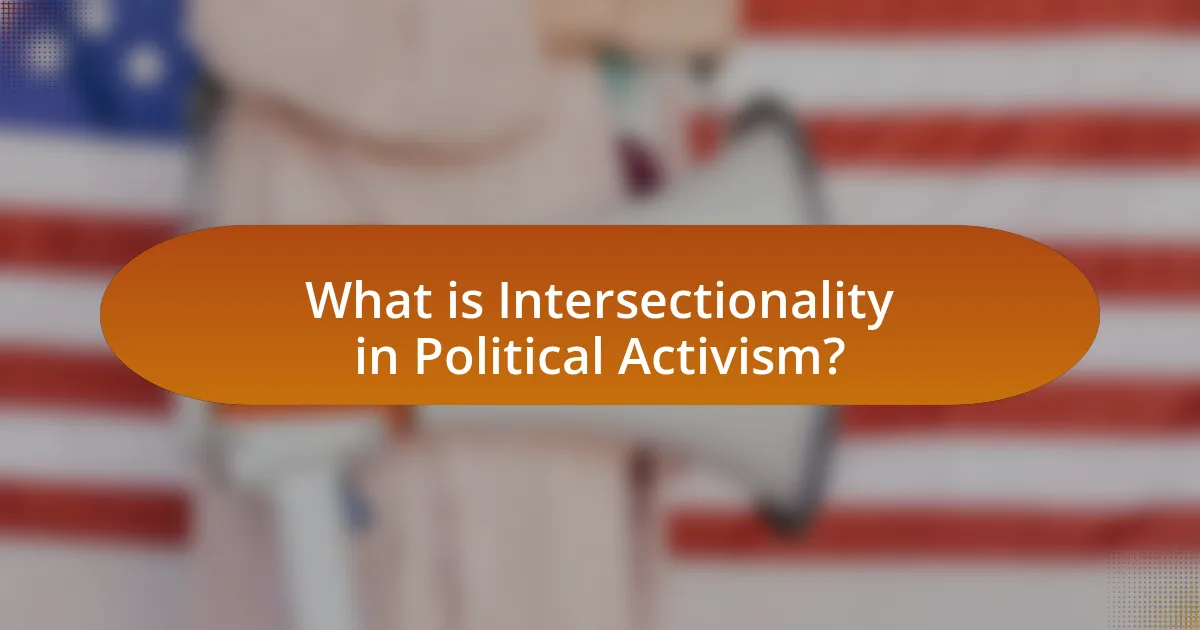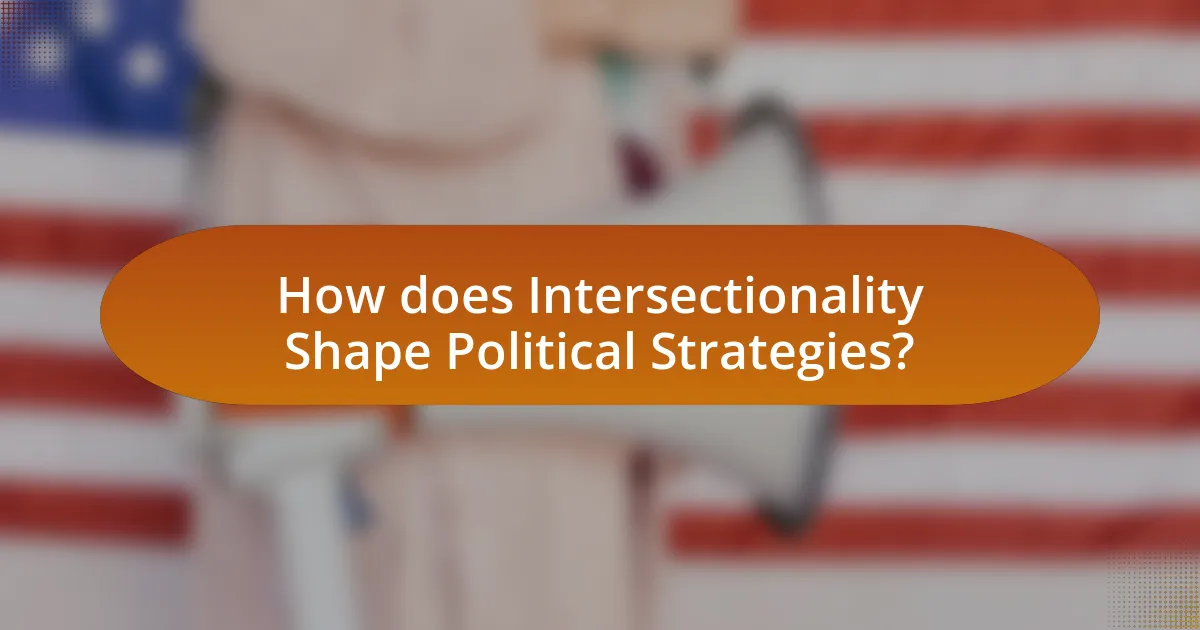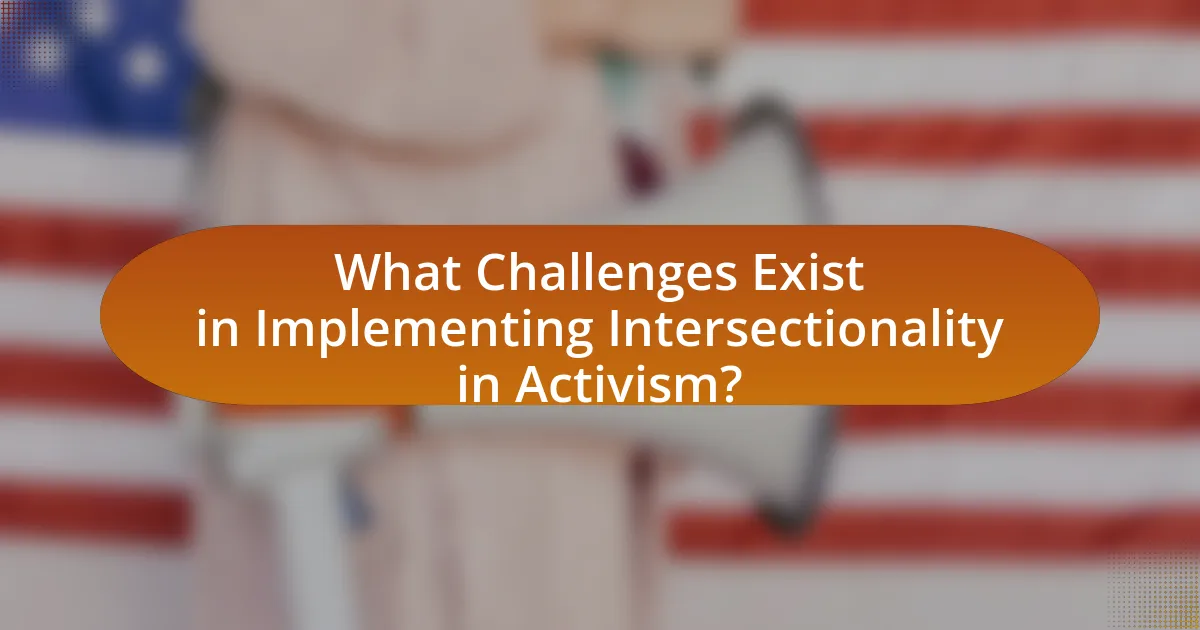Intersectionality in political activism is a framework that examines how overlapping social identities—such as race, gender, sexuality, and class—interact to create unique systems of discrimination and privilege. This concept, introduced by Kimberlé Crenshaw, emphasizes the necessity of understanding these intersections to foster inclusive movements that effectively address the diverse needs of marginalized groups. The article explores how intersectionality influences political movements, enhances coalition-building, and shapes advocacy strategies, while also addressing the challenges and misconceptions surrounding its implementation. By recognizing the interconnected nature of social categorizations, activists can develop more effective policies and practices that promote equity and justice for all individuals.

What is Intersectionality in Political Activism?
Intersectionality in political activism refers to the framework that examines how various social identities, such as race, gender, sexuality, and class, intersect and create overlapping systems of discrimination or disadvantage. This concept, introduced by Kimberlé Crenshaw in 1989, highlights that individuals experience oppression in multiple, interconnected ways, which cannot be understood by looking at social categories in isolation. For instance, a Black woman may face both racial and gender discrimination simultaneously, which shapes her experiences and activism differently than those of a white woman or a Black man. This understanding is crucial for creating inclusive movements that address the diverse needs and experiences of all marginalized groups, thereby enhancing the effectiveness and reach of political activism.
How does intersectionality influence political movements?
Intersectionality influences political movements by highlighting the interconnected nature of social categorizations such as race, gender, and class, which create overlapping systems of discrimination or disadvantage. This framework allows activists to understand and address the unique experiences of marginalized groups, leading to more inclusive and effective advocacy. For example, the Black Lives Matter movement incorporates intersectional perspectives by addressing not only police violence but also issues like economic inequality and gender discrimination faced by Black women. Research by Kimberlé Crenshaw, who coined the term “intersectionality,” emphasizes that failing to consider these overlapping identities can result in policies that overlook the needs of the most vulnerable populations. Thus, intersectionality enriches political movements by fostering solidarity and ensuring that diverse voices are represented in the fight for social justice.
What are the key principles of intersectionality?
The key principles of intersectionality include the recognition that individuals experience overlapping social identities, which can lead to unique forms of discrimination and privilege. This framework, developed by Kimberlé Crenshaw, emphasizes that social categories such as race, gender, class, and sexuality do not exist independently but interact to shape individual experiences. For instance, a Black woman may face both racial and gender discrimination simultaneously, which cannot be understood by examining race or gender in isolation. Intersectionality highlights the need for a nuanced approach in political activism to address the complexities of social justice issues effectively.
How does intersectionality address systemic inequalities?
Intersectionality addresses systemic inequalities by recognizing that individuals experience multiple, overlapping identities that contribute to their unique social positions and experiences of discrimination. This framework highlights how factors such as race, gender, class, and sexuality intersect to create complex systems of oppression, which traditional approaches often overlook. For example, a study by Crenshaw (1989) on Black women illustrates that their experiences cannot be understood solely through the lens of race or gender, as both factors interact to shape their social realities. By emphasizing these intersections, intersectionality provides a more nuanced understanding of inequality, enabling activists and policymakers to develop targeted strategies that address the specific needs of marginalized groups.
Why is intersectionality essential for effective activism?
Intersectionality is essential for effective activism because it recognizes and addresses the interconnected nature of social categorizations such as race, gender, class, and sexuality, which create overlapping systems of discrimination or disadvantage. This framework allows activists to understand how various forms of oppression interact, leading to more inclusive strategies that consider the unique experiences of marginalized groups. For instance, a study by Crenshaw (1989) highlighted how Black women face discrimination that is not solely based on race or gender but on the intersection of both, demonstrating that single-issue approaches can overlook critical aspects of their lived realities. By employing an intersectional approach, activism can more effectively advocate for policies and practices that promote equity and justice for all individuals, rather than a select few.
What are the consequences of ignoring intersectionality in activism?
Ignoring intersectionality in activism leads to the marginalization of specific groups and the perpetuation of systemic inequalities. When activists fail to consider how various social identities—such as race, gender, sexuality, and class—interact, they risk creating solutions that do not address the unique challenges faced by the most vulnerable populations. For instance, a study by Crenshaw (1989) highlighted how Black women experience discrimination differently than either Black men or white women, demonstrating that a one-size-fits-all approach to activism can overlook critical issues. This oversight can result in ineffective policies and alienation of those who are already marginalized, ultimately undermining the goals of social justice movements.
How does intersectionality enhance coalition-building among diverse groups?
Intersectionality enhances coalition-building among diverse groups by recognizing and addressing the multiple, overlapping identities and experiences that individuals possess. This framework allows groups to understand how various forms of discrimination—such as racism, sexism, and classism—interact, thereby fostering a more inclusive approach to activism. For instance, the 2017 Women’s March in the United States exemplified intersectionality by uniting women of different races, sexual orientations, and socioeconomic backgrounds, highlighting shared struggles while respecting unique challenges. This collective understanding strengthens alliances, as it encourages empathy and solidarity, ultimately leading to more effective advocacy and policy change.

How does Intersectionality Shape Political Strategies?
Intersectionality shapes political strategies by emphasizing the interconnected nature of social categorizations such as race, gender, and class, which influence individuals’ experiences and access to power. This framework allows political movements to address the diverse needs of marginalized groups more effectively, leading to more inclusive policies. For example, the Black Lives Matter movement incorporates intersectional perspectives by advocating for racial justice while also addressing issues like gender inequality and LGBTQ+ rights, thereby broadening its appeal and impact. Research by Crenshaw highlights that understanding these intersections can lead to more comprehensive strategies that resonate with a wider audience, ultimately enhancing the effectiveness of political activism.
What strategies incorporate intersectional approaches?
Strategies that incorporate intersectional approaches include coalition-building, inclusive policy advocacy, and targeted outreach initiatives. Coalition-building involves uniting diverse groups to address overlapping social injustices, ensuring that multiple perspectives are represented. Inclusive policy advocacy focuses on creating legislation that considers the unique experiences of marginalized communities, thereby promoting equity. Targeted outreach initiatives aim to engage underrepresented populations in political processes, ensuring their voices are heard and their needs are addressed. These strategies are effective because they recognize the complexity of social identities and the interconnectedness of various forms of oppression, leading to more comprehensive and effective activism.
How can activists identify intersectional issues within their communities?
Activists can identify intersectional issues within their communities by conducting comprehensive community assessments that include surveys, focus groups, and interviews to gather diverse perspectives. This approach allows activists to understand how various social identities—such as race, gender, class, and sexuality—interact and affect individuals’ experiences and challenges. Research indicates that intersectionality can reveal systemic inequalities; for instance, a study by Crenshaw (1989) highlighted how Black women face unique discrimination that is not fully addressed by either feminist or anti-racist movements alone. By analyzing data on socioeconomic status, health disparities, and access to resources, activists can pinpoint specific intersectional issues that require targeted advocacy and policy changes.
What role does data play in developing intersectional strategies?
Data is crucial in developing intersectional strategies as it provides the empirical evidence needed to understand the complex interplay of various social identities and their impacts on individuals’ experiences. By analyzing demographic data, researchers can identify disparities in access to resources, representation, and outcomes across different groups, which informs targeted interventions. For instance, a study by Crenshaw (1989) highlighted how data on race and gender can reveal unique challenges faced by women of color, emphasizing the necessity of intersectional approaches in policy-making. This data-driven understanding enables activists and policymakers to create more effective strategies that address the specific needs of diverse communities, ultimately fostering equity and inclusion in political activism.
How can intersectionality improve advocacy outcomes?
Intersectionality can improve advocacy outcomes by ensuring that diverse identities and experiences are recognized and addressed in policy-making and activism. This approach allows advocates to create more inclusive strategies that consider the unique challenges faced by individuals at the intersections of multiple marginalized identities, such as race, gender, sexuality, and socioeconomic status. Research by Crenshaw (1989) highlights that traditional advocacy often overlooks these complexities, leading to ineffective solutions. By applying an intersectional lens, advocacy efforts can better target the specific needs of various groups, ultimately leading to more equitable and effective outcomes in social justice initiatives.
What are examples of successful intersectional advocacy campaigns?
Successful intersectional advocacy campaigns include the Black Lives Matter movement, which addresses systemic racism while also advocating for LGBTQ+ rights and gender equality. This campaign has mobilized diverse communities to confront police violence and racial injustice, demonstrating the interconnectedness of various social issues. Another example is the Women’s March, which unites individuals across different identities to advocate for women’s rights, reproductive rights, and racial justice, highlighting the importance of inclusivity in feminist activism. Additionally, the #MeToo movement has successfully brought attention to sexual harassment and assault, intersecting with issues of race, class, and gender, thereby amplifying the voices of marginalized groups. These campaigns illustrate how intersectional approaches can effectively address complex social injustices.
How does intersectionality affect policy-making processes?
Intersectionality affects policy-making processes by highlighting the interconnected nature of social categorizations such as race, gender, and class, which can lead to more inclusive and equitable policies. This approach encourages policymakers to consider how various forms of discrimination and privilege overlap, thereby addressing the unique needs of marginalized groups. For instance, research by Crenshaw (1989) emphasizes that policies failing to account for intersectional identities often perpetuate systemic inequalities, as they overlook the specific challenges faced by individuals at the intersections of multiple identities. Consequently, integrating intersectionality into policy-making can lead to more effective solutions that promote social justice and equity.

What Challenges Exist in Implementing Intersectionality in Activism?
Implementing intersectionality in activism faces several challenges, primarily due to the complexity of addressing multiple, overlapping social identities. Activists often struggle to balance diverse perspectives and experiences, which can lead to fragmentation within movements. For instance, the feminist movement has historically been critiqued for prioritizing the experiences of white, middle-class women over those of women of color and LGBTQ+ individuals, highlighting the difficulty in creating an inclusive agenda. Additionally, resource allocation becomes contentious, as organizations may find it challenging to address the needs of various marginalized groups simultaneously, leading to competition for funding and attention. Furthermore, there is often a lack of understanding or training on intersectionality among activists, which can result in superficial engagement with the concept rather than a deep, structural analysis of oppression. These challenges underscore the need for ongoing education and collaboration to effectively implement intersectionality in activism.
What are common misconceptions about intersectionality?
Common misconceptions about intersectionality include the belief that it only addresses race and gender, while it actually encompasses a wide range of identities, including class, sexuality, ability, and more. Additionally, some people mistakenly think that intersectionality implies a hierarchy of oppression, suggesting that some identities are more oppressed than others, when in fact it emphasizes the interconnectedness of various forms of discrimination. Another misconception is that intersectionality is solely an academic concept, whereas it is a practical framework used in activism to address systemic inequalities. These misunderstandings can hinder effective political activism by oversimplifying the complexities of individuals’ experiences and the multifaceted nature of social justice issues.
How can activists overcome resistance to intersectional approaches?
Activists can overcome resistance to intersectional approaches by fostering inclusive dialogue and education about intersectionality’s benefits. Engaging diverse communities in discussions helps to highlight the interconnectedness of various social issues, demonstrating that addressing multiple identities leads to more effective advocacy. Research shows that movements incorporating intersectional perspectives, such as the Black Lives Matter movement, have achieved greater visibility and support by addressing the unique experiences of marginalized groups. By sharing data and personal narratives that illustrate the impact of intersectionality, activists can build empathy and understanding, ultimately reducing resistance.
What barriers do marginalized groups face in political activism?
Marginalized groups face several barriers in political activism, including systemic discrimination, lack of access to resources, and social isolation. Systemic discrimination manifests through laws and policies that disproportionately affect these groups, limiting their ability to participate fully in political processes. For example, voter ID laws can disenfranchise low-income individuals and people of color, as evidenced by studies showing that such laws reduce voter turnout among these populations. Additionally, marginalized groups often lack access to financial resources, which are crucial for organizing and mobilizing efforts, as highlighted by research from the Brennan Center for Justice indicating that funding disparities hinder grassroots movements. Social isolation further compounds these challenges, as marginalized individuals may feel disconnected from mainstream political discourse, leading to a lack of representation and voice in decision-making processes.
How can activists effectively address these challenges?
Activists can effectively address challenges by employing intersectional approaches that recognize and incorporate diverse identities and experiences. This method allows activists to understand how overlapping social identities, such as race, gender, and class, impact individuals’ experiences with oppression and privilege. Research by Crenshaw (1989) highlights that intersectionality is crucial for addressing systemic inequalities, as it reveals how various forms of discrimination are interconnected. By fostering inclusive coalitions and prioritizing marginalized voices, activists can create more comprehensive strategies that resonate with a broader audience and lead to more effective advocacy outcomes.
What resources are available for activists to learn about intersectionality?
Activists can access a variety of resources to learn about intersectionality, including books, online courses, and academic articles. Notable books such as “Intersectionality” by Kimberlé Crenshaw and “Sister Outsider” by Audre Lorde provide foundational knowledge on the subject. Online platforms like Coursera and edX offer courses on social justice and intersectionality, often featuring lectures from experts in the field. Additionally, academic journals such as “Signs: Journal of Women in Culture and Society” publish peer-reviewed articles that explore intersectional theory and its applications in activism. These resources collectively enhance understanding of how various social identities intersect and impact experiences of oppression and privilege.
How can collaboration among diverse groups strengthen activism?
Collaboration among diverse groups strengthens activism by combining varied perspectives, resources, and strategies, which enhances the effectiveness of advocacy efforts. When individuals from different backgrounds unite, they bring unique experiences and insights that can address complex social issues more comprehensively. For instance, research by the American Psychological Association indicates that diverse teams are more innovative and effective in problem-solving, leading to more impactful activism outcomes. This collaborative approach fosters solidarity, amplifies voices that may otherwise be marginalized, and creates a more inclusive movement that can mobilize broader support and drive systemic change.
What are best practices for integrating intersectionality into activism?
Best practices for integrating intersectionality into activism include actively listening to and amplifying marginalized voices, ensuring diverse representation within leadership roles, and creating inclusive spaces that acknowledge and address multiple identities and experiences. Activists should prioritize collaboration with organizations that focus on specific issues related to race, gender, sexuality, and class, as this fosters a more comprehensive understanding of systemic inequalities. Research shows that movements that embrace intersectionality, such as the Black Lives Matter movement, have been more effective in addressing the complexities of social justice issues, demonstrating that intersectional approaches lead to more impactful activism.
How can activists ensure their initiatives are inclusive and equitable?
Activists can ensure their initiatives are inclusive and equitable by actively engaging diverse communities in the planning and decision-making processes. This approach allows for the incorporation of varied perspectives and needs, which is essential for addressing systemic inequalities. Research shows that initiatives designed with input from marginalized groups are more effective; for instance, a study by the American Psychological Association found that inclusive practices lead to better outcomes in community programs. By prioritizing representation and fostering collaboration, activists can create initiatives that genuinely reflect the interests and rights of all stakeholders involved.
What steps can be taken to evaluate the effectiveness of intersectional approaches?
To evaluate the effectiveness of intersectional approaches, researchers can implement a multi-step framework that includes data collection, analysis, and stakeholder feedback. First, collecting quantitative and qualitative data on the outcomes of intersectional initiatives allows for a comprehensive assessment of their impact. For instance, surveys and interviews can reveal how different identity factors influence individuals’ experiences and outcomes in political activism.
Next, analyzing this data through intersectional lenses helps identify patterns and disparities among various demographic groups, providing insights into the effectiveness of the approaches used. For example, studies like “Intersectionality and Political Activism: A Study of Marginalized Communities” published in the Journal of Social Issues demonstrate how intersectional frameworks can highlight unique challenges faced by individuals at the intersections of multiple identities.
Finally, obtaining feedback from stakeholders involved in intersectional initiatives ensures that the evaluation process is inclusive and reflective of diverse perspectives. Engaging with community members can validate findings and inform future strategies, thereby enhancing the overall effectiveness of intersectional approaches in political activism.


